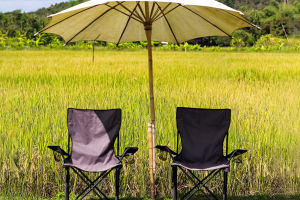Provence, located in the southeastern part of France, is renowned worldwide for its stunning landscapes of rolling hills adorned with vibrant purple fields of lavender.
This enchanting sight has become emblematic of the region, drawing tourists from around the globe and supporting a thriving local industry.
But why does Provence grow so much lavender? The answer lies in a combination of historical tradition, ideal climatic conditions, and economic factors.
Historical Tradition
Lavender cultivation in Provence dates back to antiquity. The ancient Romans were among the first to recognize the plant's valuable properties. They used lavender in baths, for medicinal purposes, and as a natural insect repellent. Over centuries, lavender became deeply ingrained in Provençal culture and tradition. The plant's name is derived from the Latin word "lavare," meaning "to wash," reflecting its historical use in bathing and cleanliness.
In the Middle Ages, lavender continued to be cultivated by monasteries, where it was used for its medicinal properties and as a preservative for stored clothing and linens. The tradition of growing lavender was passed down through generations, becoming a staple in the region's agricultural practices.
Ideal Climatic Conditions
The success of lavender cultivation in Provence is largely attributed to the region's unique climatic and geographical conditions. Lavender thrives in well-drained, rocky soils and requires full sun to flourish. The Mediterranean climate of Provence, characterized by hot, dry summers and mild winters, provides the perfect environment for this hardy plant.
The altitude also plays a significant role. Lavender grows best at elevations between 500 and 1,500 meters, where the air is dry and the soil is poor in organic matter but rich in minerals. These conditions, found in abundance in the plateaus of Provence, contribute to the high-quality lavender essential oils that the region is famous for.
Economic Factors
Lavender farming has become a vital part of Provence's economy. The plant's flowers are harvested and distilled to produce lavender essential oil, which is highly sought after in the perfume, cosmetics, and aromatherapy industries. The global demand for natural and organic products has seen a resurgence in recent years, boosting the market for pure lavender oil.
Additionally, lavender tourism plays a significant role in the region's economy. Each year, thousands of visitors flock to Provence during the lavender season, which typically runs from late June to early August. The lavender fields become a major tourist attraction, providing income for local businesses, including hotels, restaurants, and shops selling lavender-based products. The picturesque fields also serve as a popular subject for photographers and artists, further promoting the region's cultural and economic appeal.
Environmental Benefits
Beyond its economic impact, lavender cultivation has environmental benefits that contribute to its prevalence in Provence. Lavender is a drought-resistant plant, making it well-suited to the arid conditions of the region. Its deep root system helps prevent soil erosion, and the plant's presence supports local biodiversity by providing a habitat for bees and other pollinators.
Farmers in Provence have also embraced sustainable agricultural practices to protect their lavender crops and the environment. Many lavender farms are now organic, avoiding the use of synthetic pesticides and fertilizers. This not only enhances the quality of the lavender oil produced but also preserves the natural landscape and promotes ecological balance.
Challenges and Future Prospects
Despite its many advantages, lavender cultivation in Provence faces challenges. Climate change poses a significant threat, with rising temperatures and unpredictable weather patterns potentially impacting the growth and quality of lavender. Farmers must adapt to these changes by exploring new cultivation techniques and varieties that are more resilient to climatic shifts.
There is also the issue of competition from other lavender-producing regions around the world. Countries such as Bulgaria and China have increased their production of lavender, offering lower-cost alternatives to Provençal lavender. To maintain their competitive edge, Provençal lavender producers focus on maintaining high quality and leveraging the region's strong brand identity.
Provence's abundant lavender fields are the result of a rich historical tradition, favorable climatic conditions, and significant economic benefits. While challenges exist, the region's commitment to sustainable practices and the enduring appeal of its lavender ensure that Provence will remain synonymous with this fragrant and versatile plant for years to come. The fields of purple not only define the landscape but also embody the cultural and economic vitality of Provence, captivating the hearts and senses of all who experience their beauty.


